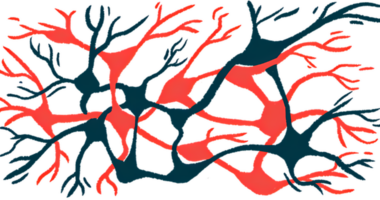2 Nanoparticles Show Potential to Prevent Amyloid Clumping

Tonhom1009/Shutterstock
Nb10 and TiNb9, two nanoparticles of a particular chemical element, effectively reduce the formation of toxic amyloid fibrils — a hallmark of Parkinson’s and Alzheimer’s diseases, a lab dish study showed.
Particularly, these nanoparticles suppressed the assembly of toxic clumps of S100A9, a pro-inflammatory molecule that is central to the amyloid-neuroinflammatory pathways of these neurodegenerative diseases.
But Nb10 and TiNb9 could not disassemble, or correct, already formed S100A9 amyloid fibrils, the researchers reported. This suggests that these nanoparticles may potentially slow, but not reverse, disease progression in amyloid-related conditions like Parkinson’s and Alzheimer’s.
“This is indeed a very important step that may form the basis of new and efficient treatments of neurodegenerative diseases in the future,” Ludmilla Morozova-Roche, PhD, the study’s senior author and a professor at the Umeå University, in Sweden, said in a press release.
“Further research is needed before we can safely say that functioning treatments can be derived from this, but the results so far have proven very promising,” Morozova-Roche added.
The study, “Polyoxometalates as Effective Nano-inhibitors of Amyloid Aggregation of Pro-inflammatory S100A9 Protein Involved in Neurodegenerative Diseases,” was published in the journal ACS Applied Materials & Interfaces.
The formation of toxic protein clumps called amyloid fibrils in the brain is a hallmark and a driver of Parkinson’s and Alzheimer’s. In Parkinson’s, the main component of these clumps is the alpha-synuclein protein, and the amyloid-beta protein in Alzheimer’s.
S100A9 is a pro-inflammatory molecule that can spontaneously form toxic amyloid fibrils. It is also prone to co-aggregate with alpha-synuclein and amyloid-beta, “which may further exacerbate the amyloid-neuroinflammatory cascade in the corresponding neurodegenerative diseases,” the researchers wrote.
As such, S100A9 is considered a key player in the amyloid-neuroinflammatory events that lead to the initiation and progression of Parkinson’s and other neurodegenerative conditions, and blocking this molecule may help to slow disease progression.
Notably, a previous study showed that suppressing S100A9 significantly reduced toxic amyloids and lessened memory impairment in an Alzheimer’s disease mouse model.
Umeå University researchers, along with colleagues in Croatia and Lithuania, now found that Nb10 and TiNb9, two polyoxometalates (POMs) nanoparticles of a chemical element called niobium, can act as potent suppressors of S100A9 amyloid assembly.
POMs represent a large, diverse, and remarkably alterable class of inorganic metal−oxygen compounds with promising biological activities and an ability to cross the blood-brain barrier — a highly selective and protective membrane that prevents large molecules and microbes circulating in the blood from reaching the brain.
Nb10 and TiNb9 are also relatively stable chemically and water-soluble.
By applying a wide spectrum of biophysical and biochemical techniques and through molecular dynamics simulations, the researchers showed that increasing concentrations of either Nb10 or TiNb9 reduced both the rate of assembly and the amount of S100A9 amyloids in a lab dish.
Notably, their highest doses completely abolished S100A9 amyloid fibrils when added at the early stages of amyloid formation, but “did not produce any significant effect, when added to preformed S100A9 amyloids,” the researchers wrote.
Further analysis showed that both nanoparticles suppressed the formation of SI00A9 amyloids by interacting with a specific region of the S100A9 protein that is critical for its self-clumping. This region was rich in lysine, one of the building blocks of proteins.
These findings suggest that blocking this lysine-rich region at the very start of S100A9 amyloid formation can prevent this process. But when amyloids are already formed, this region becomes inaccessible to Nb10 or TiNb9, and the nanoparticles have no disassembling effect.
“We have identified a very targeted mechanism to inhibit S100A9 amyloid formation and via S100A9 affect the whole amyloid-neuroinflammatory cascade,” the researchers wrote.
“The inhibition and complete hindering of S100A9 amyloid pathways may be used in therapeutic applications targeting the amyloid-neuroinflammatory cascade in the neurodegenerative diseases,” they concluded.







